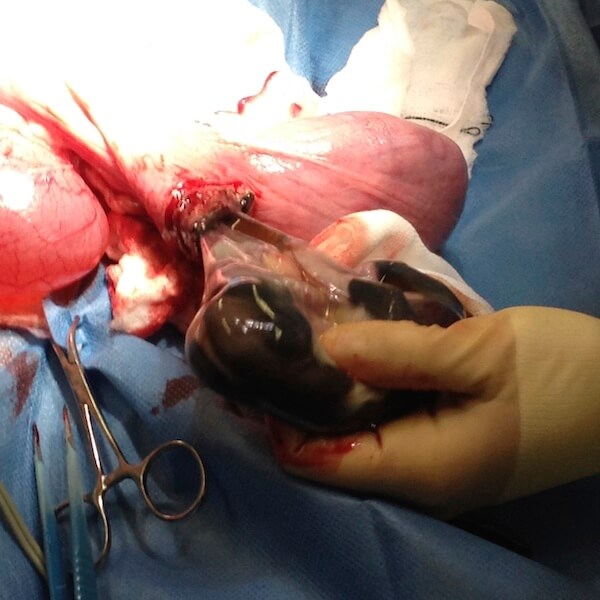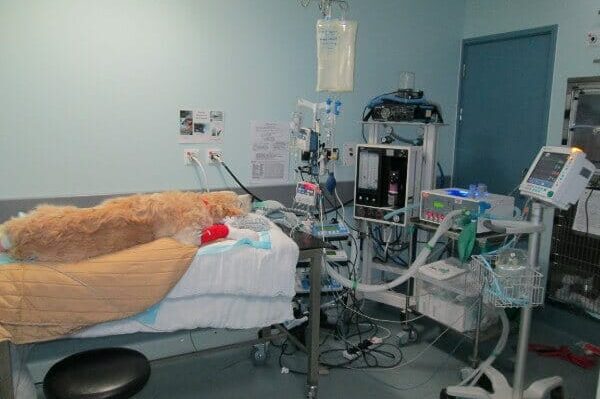Subject Anaesthesia
june

Course Details
Week 1 Preparation and Monitoring of Critical Cases Preparedness Considerations Invasive blood pressure monitoring Blood gas analysis Spirometry Learning objectives After completion of this week, participants should be able to: List generalised
Course Details
Week 1
Preparation and Monitoring of Critical Cases
Preparedness
Considerations
Invasive blood pressure monitoring
Blood gas analysis
Spirometry
Learning objectives
After completion of this week, participants should be able to:
List generalised considerations for preparing to anaesthetise emergency cases
Setup and use invasive blood pressure monitoring and how this relates to oscillometric and doppler techniques
Interpret a basic blood gas analysis and outline how this abnormality may have occurred
Explain what spirometry is and how it differs from capnography
Week 2
Abdominal Surgical Emergencies
Gastric dilatation and volvulus
Haemoabdomen
The acute abdomen
Epidural anaesthesia
Learning objectives
After completion of this week, participants should be able to:
Understand the physiological disturbances caused by gastric dilatation and volvulus
Understand the physiological disturbances caused by haemoabdomen
Understand the physiological disturbances caused by the acute abdomen
Suggest considerations for these surgeries and list possible complications that may arise during anaesthesia
List the total and relative contraindications for epidural anaesthesia
Week 3
Thoracic Surgical Emergencies
Pyothorax
Penetrating injuries
Diaphragmatic rupture
Mechanical ventilation
Learning objectives
After completion of this week, participants should be able to:
Understand the physiological disturbances caused by pyothorax
Understand the physiological disturbances caused by a penetrating injury
Understand the physiological disturbances caused by diaphragmatic rupture
Suggest considerations for these surgeries and list possible complications that may arise during anaesthesia
Feel confident to safely choose ventilator settings for use during non-emergency surgery
Week 4
Caesareans
Physiology
ASA categorisation
Anaesthesia protocols
Anaesthesia infusions (TIVA)
Learning objectives
After completion of this week, participants should be able to:
Understand the physiological considerations for caesarean section
Assign and justify the choice of an ASA category to the caesarean section patient
Suggest a safe protocol for caesarean section, with variation based on differing drug availability depending on clinical setting
Understand the basis of total intravenous anaesthesia infusions
Week 5
What’s Happening? What Should I do?
Hypoxia
Hypocapnia
Hypotension
ECG Abnormalities
Learning objectives
After completion of this week, participants should be able to:
List possible causes of, and suggest treatments for hypoxia and hypocapnia
List possible causes of hypotension and discuss the physiology of both pharmacological and non-pharmacological treatment options
Interpret the most common ECG abnormalities seen and understand how these rhythms will affect the patient, and have an understanding of possible treatment options
Week 6
CRASH!
Recover CPR guidelines
Crash box
Basic life support
Advanced life support
Learning objectives
After completion of this week, participants should be able to:
List the vital components of a crash box
Perform safe and effective chest compressions in a variety of patient sizes and conformations
Understand how to monitor the effectiveness of CPR in the clinical setting
Interpret the most common ECG rhythms seen during CPR
Understand what drug treatment options are available during CPR
The course will be fully tutored by William McFadzean and will consist of 15 hours of CPD given in various formats, including tutorials, tasks, case scenarios, forum discussions and quizzes. This course is tutored for 6 weeks, followed by a two week extension of untutored ‘catch up’ time, before the course officially ends.
All delegates will then have unlimited lifetime access to the learning material for future reference
Time
June 3 (Monday) - July 12 (Friday)
Location
Online
Speaker
William McFadzeanBVetMed, CertAVP (VA), DipECVAA, MRCVS Cave Veterinary Specialists
july

Course Details
Week 1 Preparation and Monitoring of Critical Cases Preparedness Considerations Invasive blood pressure monitoring Blood gas analysis Spirometry Learning objectives After completion of this week, participants should be able to: List generalised
Course Details
Week 1
Preparation and Monitoring of Critical Cases
Preparedness
Considerations
Invasive blood pressure monitoring
Blood gas analysis
Spirometry
Learning objectives
After completion of this week, participants should be able to:
List generalised considerations for preparing to anaesthetise emergency cases
Setup and use invasive blood pressure monitoring and how this relates to oscillometric and doppler techniques
Interpret a basic blood gas analysis and outline how this abnormality may have occurred
Explain what spirometry is and how it differs from capnography
Week 2
Abdominal Surgical Emergencies
Gastric dilatation and volvulus
Haemoabdomen
The acute abdomen
Epidural anaesthesia
Learning objectives
After completion of this week, participants should be able to:
Understand the physiological disturbances caused by gastric dilatation and volvulus
Understand the physiological disturbances caused by haemoabdomen
Understand the physiological disturbances caused by the acute abdomen
Suggest considerations for these surgeries and list possible complications that may arise during anaesthesia
List the total and relative contraindications for epidural anaesthesia
Week 3
Thoracic Surgical Emergencies
Pyothorax
Penetrating injuries
Diaphragmatic rupture
Mechanical ventilation
Learning objectives
After completion of this week, participants should be able to:
Understand the physiological disturbances caused by pyothorax
Understand the physiological disturbances caused by a penetrating injury
Understand the physiological disturbances caused by diaphragmatic rupture
Suggest considerations for these surgeries and list possible complications that may arise during anaesthesia
Feel confident to safely choose ventilator settings for use during non-emergency surgery
Week 4
Caesareans
Physiology
ASA categorisation
Anaesthesia protocols
Anaesthesia infusions (TIVA)
Learning objectives
After completion of this week, participants should be able to:
Understand the physiological considerations for caesarean section
Assign and justify the choice of an ASA category to the caesarean section patient
Suggest a safe protocol for caesarean section, with variation based on differing drug availability depending on clinical setting
Understand the basis of total intravenous anaesthesia infusions
Week 5
What’s Happening? What Should I do?
Hypoxia
Hypocapnia
Hypotension
ECG Abnormalities
Learning objectives
After completion of this week, participants should be able to:
List possible causes of, and suggest treatments for hypoxia and hypocapnia
List possible causes of hypotension and discuss the physiology of both pharmacological and non-pharmacological treatment options
Interpret the most common ECG abnormalities seen and understand how these rhythms will affect the patient, and have an understanding of possible treatment options
Week 6
CRASH!
Recover CPR guidelines
Crash box
Basic life support
Advanced life support
Learning objectives
After completion of this week, participants should be able to:
List the vital components of a crash box
Perform safe and effective chest compressions in a variety of patient sizes and conformations
Understand how to monitor the effectiveness of CPR in the clinical setting
Interpret the most common ECG rhythms seen during CPR
Understand what drug treatment options are available during CPR
The course will be fully tutored by William McFadzean and will consist of 15 hours of CPD given in various formats, including tutorials, tasks, case scenarios, forum discussions and quizzes. This course is tutored for 6 weeks, followed by a two week extension of untutored ‘catch up’ time, before the course officially ends.
All delegates will then have unlimited lifetime access to the learning material for future reference
Time
June 3 (Monday) - July 12 (Friday)
Location
Online
Speaker
William McFadzeanBVetMed, CertAVP (VA), DipECVAA, MRCVS Cave Veterinary Specialists
august

Course Details
Week 1 Preparation, Priorities and Checklists Patient safety The anaesthesia plan and patient priorities Preparation and checklists Learning objectives After completion of this week, participants should be able to: Understand
Course Details
Week 1
Preparation, Priorities and Checklists
Patient safety
The anaesthesia plan and patient priorities
Preparation and checklists
Learning objectives
After completion of this week, participants should be able to:
Understand how preparation and use of checklists improve patient safety
Prepare individual anaesthesia plans for sick patients and/or complex procedures
Understand how to prioritise important considerations
Understand how to prepare the patient and equipment to minimise harmful delays and mistakes
Construct and use relevant patient safety checklists
Week 2
Ventilation, Capnography and Neuromuscular Blockade
Physiology of spontaneous and controlled ventilation
Ventilators
Capnography
Neuromuscular blockade
Learning objectives
After completion of this week, participants should be able to:
Understand in which situations it is appropriate to use controlled ventilation
Understand how to set up a ventilator and what all the buttons do!
Understand the physiology and technology of capnography
Understand how to interpret different capnograph traces
Understand how to use and monitor neuromuscular blocking drugs
Week 3
Advanced Monitoring and Cardiovascular Support
Physiology of heart rate and blood pressure
The electrocardiogram
Measuring blood pressure
Treating hypotension and arrhythmias
Learning objectives
After completion of this week, participants should be able to:
Have a better understanding of ECG interpretation and when to worry
Understand how to interpret blood pressure measurements
Understand when and how to treat common arrhythmias
Understand different ways of treating hypotension
Week 4
Perioperative Analgesia
Analgesic drugs in the peri-anaesthetic period
Multimodal analgesia
Analgesic infusions
Using local anaesthetic techniques
Learning objectives
After completion of this week, participants should be able to:
Have an understanding of the pharmacology of analgesic drugs
Understand which drugs are useful in which situations
Select and prepare analgesic drugs for intravenous infusions
Understand and select appropriate local anaesthetic techniques for different procedures
The course will be fully tutored by Colette Jolliffe and will consist of 10 hours of CPD given in various formats, including tutorials, tasks, case studies, forum discussions and quizzes. This course is tutored for 4 weeks, followed by a two week extension of untutored ‘catch up’ time, before the course officially ends.
All delegates will then have unlimited lifetime access to the learning material for future reference
Time
August 12 (Monday) - September 6 (Friday)
Location
Online
Speaker
Colette JolliffeBVetMed, CertVA, DipECVAA, FRCVS European and RCVS Recognised Specialist in Veterinary Anaesthesia and Analgesia, Anderson Moores Veterinary Specialists



